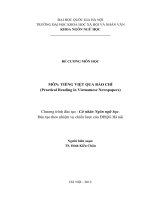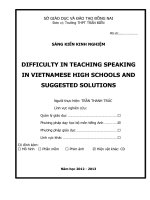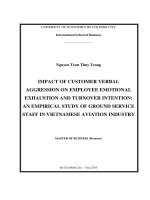classifier noun annotation in vietnamese treebank
Bạn đang xem bản rút gọn của tài liệu. Xem và tải ngay bản đầy đủ của tài liệu tại đây (1.38 MB, 54 trang )
VIETNAM NATIONAL UNIVERSITY, HANOI
UNIVERSITY OF ENGINEERING AND TECHNOLOGY
Dinh Trung Anh
DEPTH ESTIMATION FOR MULTI-VIEW VIDEO
CODING
Major: Computer Science
1 - 2015
HA NOI
VIETNAM NATIONAL UNIVERSITY, HANOI
UNIVERSITY OF ENGINEERING AND TECHNOLOGY
Dinh Trung Anh
DEPTH ESTIMATION FOR MULTI-VIEW VIDEO
CODING
Major: Computer Science
Major: Computer Science
Supervisor: Dr. Le Thanh Ha
Co-Supervisor:
Supervisor: Dr. BSc.
Le Thanh
Nguyen
HaMinh Duc
Co-Supervisor: BS. Nguyen Minh Duc
2 – 2015
HA NOI
–
AUTHORSHIP
“I hereby declare that the work contained in this thesis is of my own and has not been
previously submitted for a degree or diploma at this or any other higher education
institution. To the best of my knowledge and belief, the thesis contains no materials
previously published or written by another person except where due reference or
acknowledgement is made.”
Signature:………………………………………………
i
SUPERVISOR’S APPROVAL
“I hereby approve that the thesis in its current form is ready for committee examination as
a requirement for the Bachelor of Computer Science degree at the University of
Engineering and Technology.”
Signature:………………………………………………
ii
ACKNOWLEDGEMENT
Firstly, I would like to express my sincere gratitude to my advisers Dr. Le Thanh
Ha of University of Engineering and Technology, Viet Nam National University, Hanoi
and Bachelor Nguyen Minh Duc for their instructions, guidance and their research
experiences.
Secondly, I am grateful to thank all the teachers of University of Engineering and
Technology, VNU for their invaluable lessons which I have learnt during my university
life.
I would like to also thank my friends in K56CA class, University of Engineering
and Technology, VNU.
Last but not least, I greatly appreciate all the help and support that members of
Human Machine Interaction Laboratory of University of Engineering and Technology and
Kotani Laboratory of Japan Advanced Institute of Science and Technology gave me during
this project.
Hanoi, May 8th, 2015
Dinh Trung Anh
iii
ABSTRACT
With the advance of new technologies in the entertainment industry, the FreeViewpoint television (TV), the next generation of 3D medium, is going to give users a
completely new experience of watching TV as they can freely change their viewpoints.
Future TV is going to not only show but also let users “live” inside the 3D scene. A simple
approach for free viewpoint TV is to use current multi-view video technology, which uses
a system of multiple cameras to capture the scene. The views at positions where there is a
lack of camera viewpoints must be synthesized with the support of depth information. This
thesis is to study Depth Estimation Reference Software (DERS) of Moving Pictures Expert
Group (MPEG) which is a reference software for estimating depth from color videos
captured by multi-view cameras. It also provides a method, which uses stored background
information to improve the depth quality taken from the reference software. The
experimental results exhibit the quality improvement of the depth maps estimated from the
proposed method in comparison with those from the traditional method in some cases.
Keywords: Multi-view Video Coding, Depth Estimation Reference Software,
Graph Cut.
iv
TÓM TẮT
Với sự phát triển của công nghệ mới trong ngành công nghiệp giải trí, ti vi góc nhìn
tự do, thế hệ tiếp theo của phương tiện truyền thông, sẽ cho người dùng một trải nghiệm
hoàn toàn mới về ti vi khi họ có thể tự do thay đổi góc nhìn. Ti vi tương lai sẽ không chỉ
hiển thị hình ảnh mà còn cho người dùng “sống” trong khung cảnh 3D. Một hướng tiếp
cận đơn giản cho ti vi đa góc nhìn là sử dụng công nghệ hiện có của video đa góc nhìn với
cả một hệ thống máy quay để chụp lại khung cảnh. Hình ảnh ở các góc nhìn không có
camera phải được tổng hợp với sự hỗ trợ của thông tin độ sâu. Luận văn này sẽ tìm hiểu về
Depth Estimation Reference Software (DERS) của Moving Pictures Expert Group
(MPEG), phần mềm tham khảo để ước lượng độ sâu từ các video màu chụp bởi các máy
quay đa góc nhìn. Đồng thời khóa luận cũng sẽ đưa ra phương pháp mới sử dụng lưu trữ
thông tin nền để cải tiến phần mềm tham khảo. Kết quả thí nghiệm cho thấy sự cái thiện
chất lượng ảnh độ sâu của phương pháp được đề xuất khi so sánh với phương pháp truyền
thống trong một số trường hợp.
Từ khóa: Nén video đa góc nhìn, Phần mềm Ứớc lượng Độ sâu Tham khảo, Cắt
trên Đồ thị
v
CONTENTS
AUTHORSHIP .......................................................................................................... i
SUPERVISOR’S APPROVAL ................................................................................ ii
ACKNOWLEDGEMENT ....................................................................................... iii
ABSTRACT ............................................................................................................ iv
TÓM TẮT ................................................................................................................ v
CONTENTS ............................................................................................................ vi
LIST OF FIGURES ............................................................................................... viii
LIST OF TABLES ................................................................................................... x
ABBREVATIONS .................................................................................................. xi
Chapter 1 .................................................................................................................. 1
INTRODUCTION .................................................................................................... 1
1.1. Introduction and motivation .......................................................................... 1
1.2. Objectives ...................................................................................................... 2
1.3. Organization of the thesis .............................................................................. 3
Chapter 2 .................................................................................................................. 4
DEPTH ESTIMATION REFERENCE SOFTWARE ............................................. 4
2.1. Overview of Depth Estimation Reference Software ..................................... 4
2.2. Disparity - Depth Relation ............................................................................. 8
2.3. Matching cost ................................................................................................. 9
2.3.1. Pixel matching....................................................................................... 10
2.3.2. Block matching ..................................................................................... 10
vi
2.3.3. Soft-segmentation matching ................................................................. 11
2.3.4. Epipolar Search matching ..................................................................... 12
2.4. Sub-pixel Precision ...................................................................................... 13
2.5. Segmentation ............................................................................................... 15
2.6. Graph Cut ..................................................................................................... 16
2.6.1. Energy Function .................................................................................... 16
2.6.2. Optimization.......................................................................................... 18
2.6.3. Temporal Consistency........................................................................... 20
2.6.4. Results ................................................................................................... 21
2.7. Plane Fitting ................................................................................................. 22
2.8. Semi-automatic modes................................................................................. 23
2.8.1. First mode ............................................................................................. 23
2.8.2. Second mode ......................................................................................... 24
2.8.3. Third mode ............................................................................................ 27
Chapter 3 ................................................................................................................ 28
THE METHOD: BACKGROUND ENHANCEMENT ........................................ 28
3.1. Motivation example ..................................................................................... 28
3.2. Details of Background Enhancement .......................................................... 30
Chapter 4 ................................................................................................................ 33
RESULTS AND DISCUSSIONS .......................................................................... 33
4.1. Experiments Setup ....................................................................................... 33
4.2. Results .......................................................................................................... 34
Chapter 5 ................................................................................................................ 38
CONCLUSION ...................................................................................................... 38
REFERENCES ....................................................................................................... 39
vii
LIST OF FIGURES
Figure 1. Basic configuration of FTV system [1]. ................................................... 2
Figure 2. Modules of DERS ..................................................................................... 5
Figure 3. Examples of the relation between disparity and depth of objects............. 7
Figure 4. The disparity is given by the difference 𝑑 = 𝑥𝐿 − 𝑥𝑅, where 𝑥𝐿 is the x-
coordinate of the projected 3D coordinate 𝑥𝑃 onto the left camera image plane 𝐼𝑚𝐿 and
𝑥𝑅 is the x-coordinate of the projection onto the right image plane 𝐼𝑚𝑅 [7]. .................... 8
Figure 5. Exampled rectified pair of images from “Poznan_Game” sequence [11].
........................................................................................................................................... 12
Figure 6. Explanation of epipolar line search [11]. ................................................ 13
Figure 7. Matching precisions with searching in horizontal direction only [12] ... 14
Figure 8. Explanation of vertical up-sampling [11]. .............................................. 14
Figure 9. Color reassignment after Segmentation for invisibility. From (a) to (c):
cvPyrMeanShiftFiltering, cvPyrSegmentation and cvKMeans2 [9]. ................................ 15
Figure 10. An example of 𝐺𝛼 for a 1D image. The set of pixels in the image is 𝑉 =
{𝑝, 𝑞, 𝑟, 𝑠} and the current partition is 𝑃 = {𝑃1, 𝑃2, 𝑃𝛼} where 𝑃1 = {𝑝}, 𝑃2 = {𝑞, 𝑟},
and 𝑃𝛼 = {𝑠}. Two auxiliary nodes 𝑎 = 𝑎{𝑝, 𝑞}, 𝑏 = 𝑎{𝑟, 𝑠} are introduced between
neighboring pixels separated in the current partition. Auxiliary nodes are added at the
boundary of sets 𝑃𝑙 [14]. ................................................................................................... 18
Figure 11. Properties of a minimum cut 𝐶 on 𝐺𝛼 for two pixel 𝑝,q such that 𝑑𝑝 ≠
𝑑𝑞. Dotted lines show the edges cut by 𝐶and solid lines show the edges in the induced
graph 𝐺𝐶 = 𝑉, 𝐸 − 𝐶 [14]. .......................����������������������������������������������������������������������������������������������������������������������������������������������������������������������������������������������������������������������������������������������������������������������������������������������������������������������������������������������������������������������������������������������������������������������������������������������������������������������������������������������������������������������������������������������������������������������������������������������������������������������������������������������������������������������������������������������������������������������������������������������������������������������������������������������������������������������������������������������������������������������������������������������������������������������������������������������������������������������������������������������������������������������������������������������������������������������������������������������������������������������������������������������������������������������������������������������������������������������������������������������������������������������������������������������������������������������������������������������������������������������������������������������������������������������������������������������������������������������������������������������������������������������������������������������������������������������������������������������������������������������������������������������������������������������������������������������������������������������������������������������������������������������������������������������������������������������������������������������������������������������������������������������������������������������������������������������������������������������������������������������������������������������������������������������������������������������������������������������������������������������������������������������������������������������������������������������������������������������������������������������������������������������������������������������������������������������������������������������������������������������������������������������������������������������������������������������������������������������������������������������������������������������������������������������������������������������������������������������������������������������������������������������������������������������������������������������������������������������������������������������������������������������������������������������������������������������������������������������������������������������������������������������������������������������������������������������������������������������������������������������������������������������������������������������������������������������������������������������������������������������������������������������������������������������������������������������������������������������������������������������������������������������������������������������������������������������������������������������������������������������������������������������������������������������������������������������������������������������������������������������������������������������������������������������������������������������������������������������������������������������������������������������������������������������������������������������������������������������������������������������������������������������������������������������������������������������������������������������������������������������������������������������������������������������������������������������������������������������������������������������������������������������������������������������������������������������������������������������������������������������������������������������������������������������������������������������������������������������������������������������������������������������������������������������������������������������������������������������������������������������������������������������������������������������������������������������������������������������������������������������������������������������������������������������������������������������������������������������������������������������������������������������������������������������������������������������������������������������������������������������������������������������������������������������������������������������������������������������������������������������������������������������������������������������������������������������������������������������������������������������������������������������������������������������������������������������������������������������������������������������������������������������������������������������������������������������������������������������������������������������������������������������������������������������������������������������������������������������������������������������������������������������������������������������������������������������������������������������������������������������������������������������������������������������������������������������������������������������������������������������������������������������������������������������������������������������������������������������������������������������������������������������������������������������������������������������������������������������������������������������������������������������������������������������������������������������������������������������������������������������������������������������������������������������������������������������������������������������������������������������������������������������������������������������������������������������������������������������������������������������������������������������������������������������������������������������������������������������������������������������������������������������������������������������������������������������������������������������������������������������������������������������������������������������������������������������������������������������������������������������������������������������������������������������������������������������������������������������������������������������������������������������������������������������������������������������������������������������������������������������������������������������������������������������������������������������������������������������������������������������������������������������������������������������������������������������������������������������������������������������������������������������������������������������������������������������������������������������������������������������������������������������������������������������������������������������������������������������������������������������������������������������������������������������������������������������������������������������������������������������������������������������������������������������������������������������������������������������������������������������������������������������������������������������������������������������������������������������������������������������������������������������������������������������������������������������������������������������������������������������������������������������������������������������������������������������������������������������������������������������������������������������������������������������������������������������������������������������������������������������������������������������������������������������������������������������������������������������������������������������������������������������������������������������������������������������������������������������������������������������������������������������������������������������������������������������������������������������������������������������������������������������������������������������������������������������������������������������������������������������������������������������������������������������������������������������������������������������������������������������������������������������������������������������������������������������������������������������������������������������������������������������������������������������������������������������������������������������������������������������������������������������������������������������������������������������������������������������������������������������������������������������������������������������������������������������������������������������������������������������������������������������������������������������������������������������������������������������������������������������������������������������������������������������������������������������������������������������������������������������������������������������������������������������������������������������������������������������������������������������������������������������������������������������������������������������������������������������������������������������������������������������������������������������������������������������������������������������������������������������������������������������������������������������������������������������������������������������������������������������������������������������������������������������������������������������������������������������������������������������������������������������������������������������������������������������������������������������������������������������������������������������������������������������������������������������������������������������������������������������������������������������������������������������������������������������������������������������������������������������������������������������������������������������������������������������������������������������������������������������������������������������������������������������������������������������������������������������������������������������������������������������������������������������������������������������������������������������������������������������������������������������������������������������������������������������������������������������������������������������������������������������������������������������������������������������������������������������������������������������������������������������������������������������������������������������������������������������������������������������������������������������������������������������������������������������������������������������������������������������������������������������������������������������������������������������������������������������������������������������������������������������������������������������������������������������������������������������������������������������������������������������������������������������������������������������������������������������������������������������������������������������������������������������������������������������������������������������������������������������������������������������������������������������������������������������������������������������������������������������������������������������������������������������������������������������������������������������������������������������������������������������������������������������������������������������������������������������������������������������������������������������������������������������������������������������������������������������������������������������������������������������������������������������������������������������������������������������������������������������������������������������������������������������������������������������������������������������������������������������������������������������������������������������������������������������������������������������������������������������������������������������������������������������������������������������������������������������������������������������������������������������������������������������������������������������������������������������������������������������������������������������������������������������������������������������������������������������������������������������������������������������������������������������������������������������������������������������������������������������������������������������������������������������������������������������������������������������������������������������������������������������������������������������������������������������������������������������������������������������������������������������������������������������������������������������������������������������������������������������������������������������������������������������������������������������������������������������������������������������������������������������������������������������������������������������������������������������������������������������������������������������������������������������������������������������������������������������������������������������������������������������������������������������������������������������������������������������������������������������������������������������������������������������������������������������������������������������������������������������������������������������������������������������������������������������������������������������������������������������������������������������������������������������������������������������������������������������������������������������������������������������������������������������������������������������������������������������������������������������������������������������������������������������������������������������������������������������������������������������������������������������������������������������������������������������������������������������������������������������������������������������������������������������������������������������������������������������������������������������������������������������������������������������������������������������������������������������������������������������������������������������������������������������������������������������������������������������������������������������������������������������������������������������������������������������������������������������������������������������������������������������������������������������������������������������������������������������������������������������������������������������������������������������������������������������������������������������������������������������������������������������������������������������������������������������������������������������������������������������������������������������������������������������������������������������������������������������������������������������������������������������������������������������������������������������������������������������������������������������������������������������������������������������������������������������������������������������������������������������������������������������������������������������������������������������������������������������������������������������������������������������������������������������������������������������������������������������������������������������������������������������������������������������������������������������������������������������������������������������������������������������������������������������������������������������������������������������������������������������������������������������������������������������������������������������������������������������������������������������������������������������������������������������������������������������������������������������������������������������������������������������������������������������������������������������������������������������������������������������������������������������������������������������������������������������������������������������������������������������������������������������������������������������������������������������������������������������������������������������������������������������������������������������������������������������������������������������������������������������������������������������������������������������������������������������������������������������������������������������������������������������������������������������������������������������������������������������������������������������������������������������������������������������������������������������������������������������������������������������������������������������������������������������������������������������������������������������������������������������������������������������������������������������������������������������������������������������������������������������������������������������������������������������������������������������������������������������������������������������������������������������������������������������������������������������������������������������������������������������������������������������������������������������������������������������������������������������������������������������������������������������������������������������������������������������������������������������������������������������������������������������������������������������������������������������������������������������������������������������������������������������������������������������������������������������������������������������������������������������������������������������������������������������������������������������������������������������������������������������������������������������������������������������������������������������������������������������������������������������������������������������������������������������������������������������������������������������������������������������������������������������������������������������������������������������������������������������������������������������������������������������������������������������������������������������������������������������������������������������������������������������������������������������������������������������������������������������������������������������������������������������������������������������������������������������������������������������������������������������������������������������������������������������������������������������������������������������������������������������������������������������������������������������������������������������������������������������������������������������������������������������������������������������������������������������������������������������������������������������������������������������������������������������������������������������������������������������������������������������������������������������������������������������������������������������������������������������������������������������������������������������������������������������������������������������������������������������������������������������������������������������������������������������������������������������������������������������������������������������������������������������������������������������������������������������������������������������������������������������������������������������������������������������������������������������������������������������������������������������������������������������������������������������������������������������������������������������������������������������������������������������������������������������������������������������������������������������������������������������������������������������������������������������������������������������������������������������������������������������������������������������������������������������������������������������������������������������������������������������������������������������������������������������������������������������������������������������������������������������������������������������������������������������������������������������������������������������������������������������������������������������������������������������������������������������������������������������������������������������������������������������������������������������������������������������������������������������������������������������������������������������������������������������������������������������������������������������������������������������������������������������������������������������������������������������������������������������������������������������������������������������������������������������������������������������������������������������������������������������������������������������������������������������������������������������������������������������������������������������������������������������������������������������������������������������������������������������������������������������������������������������������������������������������������������������������������������������������������������������������������������������������������������������������������������������������������������������������������������������������������������������������������������������������������������������������������������������������������������������������������������������������������������������������������������������������������������������������������������������������������������������������������������������������������������������������������������������������������������������������������������������������������������������������������������������������������������������������������������������������������������������������������������������������������������������������������������������������������������������������������������������������������������������������������������������������������������������������������������������������������������������������������������������������������������������������������������������������������������������������������������������������������������������������������������������������������������������������������������������������������������������������������������������������������������������������������������������������������������������������������������������������������������������������������������������������������������������������������������������������������������������������������������������������������������������������������������������������������������������������������������������������������������������������������������������������������������������������������������������������������������������������������������������������������������������������������������������������������������������������������������������������������������������������������������������������������������������������������������������������������������������������������������������������������������������������������������������������������������������������������������������������������������������������������������������������������������������������������������������������������������������������������������������������������������������������������������������������������������������������������������������������������������������������������������������������������������������������������������������������������������������������������������������������������������������������������������������������������������������������������������������������������������������������������������������������������������������������������������������������������������������������������������������������������������������������������������������������������������������������������������������������������������������������������������������������������������������������������������������������������������������������������������������������������������������������������������������������������������������������������������������������������������������������������������������������������������������������������������������������������������������������������������������������������������������������������������������������������������������������������������������������������������������������������������������������������������������������������������������������������������������������������������������������������������������������������������������������������������������������������������������������������������������������������������������������������������������������������������������������������������������������������������������������������������������������������������������������������������������������������������������������������������������������������������������������������������������������������������������������������������������������������������������������������������������������������������������������������������������������������������������������������������������������������������������������������������������������������������������������������������������������������������������������������������������������������������������������������������������������������������������������������������������������������������������������������������������������������������������������������������������������������������������������������������������������������������������������������������������������������������������������������������������������������������������������������������������������������������������������������������������������������������������������������������������������������������������������������������������������������������������������������������������������������������������������������������������������������������������������������������������������������������������������������������������������������������������������������������������������������������������������������������������������������������������������������������������������������������������������������������������������������������������������������������������������������������������������������������������������������������������������������������������������������������������������������������������������������������������������������������������������������������������������������������������������������������������������������������������������������������������������������������������������������������������������������������������������������������������������������������������������������������������������������������������������������������������������������������������������������������������������������������������������������������������������������������������������������������������������������������������������������������������������������������������������������������������������������������������������������������������������������������������������������������������������������������������������������������������������������������������������������������������������������������������������������������������������������������������������������������������������������������������������������������������������������������������������������������������������������������������������������������������������������������������������������������������������������������������������������������������������������������������������������������������������������������������������������������������������������������������������������������������������������������������������������������������������������������������������������������������������������������������������������������������������������������������������������������������������������������������������������������������������������������������������������������������������������������������������������������������������������������������������������������������������������������������������������������������������������������������������������������������������������������������������������������������������������������������������������������������������������������������������������������������������������������������������������������������������������������������������������������������������������������������������������������������������������������������������������������������������������������������������������������������������������������������������������������������������������������������������������������������������������������������������������������������������������������������������������������������������������������������������������������������������������������������������������������������������������������������������������������������������������������������������������������������������������������������������������������������������������������������������������������������������������������������������������������������������������������������������������������������������������������������������������������������������������������������������������������������������������������������������������������������������������������������������������������������������������������������������������������������������������������������������������������������������������������������������������������������������������������������������������������������������������������������������������������������������������������������������������������������������������������������������������������������������������������������������������������������������������������������������������������������������������������������������������������������������������������������������������������������������������������������������������������������������������������������������������������������������������������������������������������������������������������������������������������������������������������������������������������������������������������������������������������������������������������������������������������������������������������������������������������������������������������������������������������������������������������������������������������������������������������������������������������������������������������������������������������������������������������������������������������������������������������������������������������������������������������������������������������������������������������������������������������������������������������������������������������������������������������������������������������������������������������������������������������������������������������������������������������������������������������������������������������������������������������������������������������������������������������������������������������������������������������������������������������������������������������������������������������������������������������������������������������������������������������������������������������������������������������������������������������������������������������������������������������������������������������������������������������������������������������������������������������������������������������������������������������������������������������������������������������������������������������������������������������������������������������������������������������������������������������������������������������������������������������������������������������������������������������������������������������������������������������������������������������������������������������������������������������������������������������������������������������������������������������������������������������������������������������������������������������������������������������������������������������������������������������������������������������������������������������������������������������������������������������������������������������������������������������������������������������������������������������������������������������������������������������������������������������������������������������������������������������������������������������������������������������������������������������������������������������������������������������������������������������������������������������������������������������������������������������������������������������������������������������������������������������������������������������������������������������������������������������������������������������������������������������������������������������������������������������������������������������������������������������������������������������������������������������������������������������������������������������������������������������������������������������������������������������������������������������������������������������������������������������������������������������������������������������������������������������������������������������������������������������������������������������������������������������������������������������������������������������������������������������������������������������������������������������������������������������������������������������������������������������������������������������������������������������������������������������������������������������������������������������������������������������������������������������������������������������������������������������������������������������������������������������������������������������������������������������������������������������������������������������������������������������������������������������������������������������������������������������������������������������������������������������������������������������������������������������������������������������������������������������������������������������������������������������������������������������������������������������������������������������������������������������������������������������������������������������������������������������������������������������������������������������������������������������������������������������������������������������������������������������������������������������������������������������������������������������������������������������������������������������������������������������������������������������������������������������������������������������������������������������������������������������������������������������������������������������������������������������������������������������������������������������������������������������������������������������������������������������������������������������������������������������������������������������������������������������������������������������������������������������������������������������������������������������������������������������������������������������������������������������������������������������������������������������������������������������������������������������������������������������������������������������������������������������������������������������������������������������������������������������������������������������������������������������������������������������������������������������������������������������������������������������������������������������������������������������������������������������������������������������������������������������������������������������������������������������������������������������������������������������������������������������������������������������������������������������������������������������������������������������������������������������������������������������������������������������������������������������������������������������������������������������������������������������������������������������������������������������������������������������������������������������������������������������������������������������������������������������������������������������������������������������������������������������������������������������������������������������������������������������������������������������������������������������������������������������������������������������������������������������������������������������������������������������������������������������������������������������������������������������������������������������������������������������������������������������������������������������������������������������������������������������������������������������������������������������������������������������������������������������������������������������������������������������������������������������������������������������������������������������������������������������������������������������������������������������������������������������������������������������������������������������������������������������������������������������������������������������������������������������������������������������������������������������������������������������������������������������������������������������������������������������������������������������������������������������������������������������������������������������������������������������������������������������������������������������������������������������������������������������������������������������������������������������������������������������������������������������������������������������������������������������������������������������������������������������������������������������������������������������������������������������������������������������������������������������������������������������������������������������������������������������������������������������������������������������������������������������������������������������������������������������������������������������������������������������������������������������������������������������������������������������������������������������������������������������������������������������������������������������������������������������������������������������������������������������������������������������������������������������������������������������������������������������������������������������������������������������������������������������������������������������������������������������������������������������������������������������������������������������������������������������������������������������������������������������������������������������������������������������������������������������������������������������������������������������������������������������������������������������������������������������������������������������������������������������������������������������������������������������������������������������������������������������������������������������������������������������������������������������������������������������������������������������������������������������������������������������������������������������������������������������������������������������������������������������������������������������������������������������������������������������������������������������������������������������������������������������������������������������������������������������������������������������������������������������������������������������������������������������������������������������������������������������������������������������������������������������������������������������������������������������������������������������������������������������������������������������������������������������������������������������������������������������������������������������������������������������������������������������������������������������������������������������������������������������������������������������������������������������������������������������������������������������������������������������������������������������������������������������������������������������������������������������������������������������������������������������������������������������������������������������������������������������������������������������������������������������������������������������������������������������������������������������������������������������������������������������������������������������������������������������������������������������������������������������������������������������������������������������������������������������������������������������lower than the foreground, the intensities of pixels in the foreground do not
change much over frames. The detected background of the previous frame, therefore, can
be stored and used as the reference to discriminate the background from the foreground. In
the method, two types of background maps including background intensity map and
background depth map are stored over frames (Figure 20). To reduce the noise created by
falsely estimate a foreground pixel as a background one, an exponential filter is applied to
background intensity map.
30
Figure 19. Motion search
𝛼𝐵𝐼𝑝𝑟𝑒𝑣 (𝑥, 𝑦) + (1 − 𝛼)𝐼𝑐 (𝑥, 𝑦)𝑖𝑓 𝑑(𝑥, 𝑦) < 𝑇ℎ𝑟𝑒𝑠𝑏𝑔 𝑎𝑛𝑑 𝐵𝐼𝑝𝑟𝑒𝑣 (𝑥, 𝑦) ≠ 255
𝑖𝑓 𝑑(𝑥, 𝑦) < 𝑇ℎ𝑟𝑒𝑠𝑏𝑔 𝑎𝑛𝑑 𝐵𝐼𝑝𝑟𝑒𝑣 (𝑥, 𝑦) = 255
𝐵𝐼(𝑥, 𝑦) = {𝐼𝑐 (𝑥, 𝑦)
𝐵𝐼𝑝𝑟𝑒𝑣 (𝑥, 𝑦)
𝑖𝑓 𝑑(𝑥, 𝑦) ≥ 𝑇ℎ𝑟𝑒𝑠𝑏𝑔
𝐵𝐷 (𝑥, 𝑦) = {
Where
𝑑 (𝑥, 𝑦) 𝑖𝑓 𝑑 (𝑥, 𝑦) < 𝑇ℎ𝑟𝑒𝑠𝑏𝑔
,
𝐵𝐷 (𝑥, 𝑦) 𝑜𝑡ℎ𝑒𝑟𝑤𝑖𝑠𝑒
(15)
(16)
𝑇ℎ𝑟𝑒𝑠𝑏𝑔 is the depth threshold to separate the depth of foreground and that
of background.
As mentioned above, a background enhancement term is added into the data term
to preserve the correct depth of previous frames:
𝐸𝑑𝑎𝑡𝑎 (𝑑)
0
2𝐶(𝑥, 𝑦, 𝑑(𝑥, 𝑦))
= 𝐶(𝑥, 𝑦, 𝑑(𝑥, 𝑦)) + 𝐶𝑡𝑒𝑚𝑝𝑜𝑟𝑎𝑙 (𝑥, 𝑦, 𝑑(𝑥, 𝑦))
𝐶(𝑥, 𝑦, 𝑑(𝑥, 𝑦)) + 𝐶𝑏𝑔𝑒𝑛ℎ𝑎𝑛𝑐𝑒 (𝑥, 𝑦, 𝑑(𝑥, 𝑦))
𝑖𝑓 𝑀𝑆(𝑥, 𝑦) = 𝑠𝑡𝑎𝑡𝑖𝑐 𝑎𝑛𝑑 𝑑(𝑥, 𝑦) = 𝑑𝑖𝑛𝑖𝑡 (𝑥, 𝑦)
𝑖𝑓 𝑀𝑆(𝑥, 𝑦) = 𝑠𝑡𝑎𝑡𝑖𝑐 𝑎𝑛𝑑 𝑑(𝑥, 𝑦) ≠ 𝑑𝑖𝑛𝑖𝑡 (𝑥, 𝑦)
𝑖𝑓 𝑡𝑒𝑚𝑝𝑜𝑟𝑎𝑙 𝑐𝑜𝑛𝑠𝑖𝑠𝑡𝑒𝑛𝑐𝑦
𝑖𝑓 𝑏𝑎𝑐𝑘𝑔𝑟𝑜𝑢𝑛𝑑 𝑒𝑛ℎ𝑎𝑛𝑐𝑒
{𝐶(𝑥, 𝑦, 𝑑(𝑥, 𝑦))
𝑜𝑡ℎ𝑒𝑟𝑤𝑖𝑠𝑒
where
31
(17)
temporal consistency:∑(𝑖,𝑗) ∈ 𝑤(𝑥,𝑦)|𝐼𝑐 (𝑖, 𝑗) − 𝐼𝑐𝑝𝑟𝑒𝑣 (𝑖, 𝑗)| < 𝑇ℎ𝑟𝑒𝑠𝑚𝑜𝑡𝑖𝑜𝑛 like (9)
background enhance: not temporal consistency and
|𝐼𝑐 (𝑥, 𝑦) − 𝐵𝐼(𝑥, 𝑦)| < 𝑇ℎ𝑟𝑒𝑠
If there is the manual static map, it will be used firstly to change the data term. Then,
block motion search 16x16 is applied to find the no motion area, which temporal
consistency term is used to protect the depth of the previous frame. In detected motion area,
intensities of pixels are compared with the stored intensities of pixels of the background
intensity map to find the background of sequence and the background depth map is used
as the reference for the previous depth.
Figure 20. Background Intensity map and Background Depth map
32
Chapter 4
RESULTS AND DISCUSSIONS
4.1. Experiments Setup
As the lack of the resource of the ground truth of Champagne and Pantomime, the
experiments to test the result of new method base only the color input sequence. Figure 21
shows the idea of the experiments. The color sequences from camera 38, 39 and 40 are
used to estimate the depth sequence of Camera 39; those from camera 40, 41 and 42 are
used to estimate the depth sequence of camera 41. Based on the existing depth and color
sequences of camera 39 and camera 41, a color sequence from virtual camera 40 is
synthesized and compared with that from real camera 40. The Peak Signal Noise Ratio
(PSNR) index is calculated at each frame and used as the objective measurement for the
quality of depth estimation in these experiments.
𝑃𝑆𝑁𝑅 = 20 log10
max|𝐼𝑜𝑟𝑖𝑔𝑖𝑛 (𝑥,𝑦)|
(𝑥,𝑦)
√𝑀𝑆𝐸
(18)
,
Where
𝑚−1 𝑛−1
𝑀𝑆𝐸 = ∑ ∑(𝐼𝑜𝑟𝑖𝑔𝑖𝑛 (𝑥, 𝑦) − 𝐼𝑠𝑦𝑛 (𝑥, 𝑦))
and
𝑥=0 𝑦=0
2
𝐼𝑜𝑟𝑖𝑔𝑖𝑛 , 𝐼𝑠𝑦𝑛 is the original and synthesized images, respectively
𝑚, 𝑛 is the width and height of both 𝐼𝑜𝑟𝑖𝑔𝑖𝑛 and 𝐼𝑠𝑦𝑛
33
“Greater resemblance between the images implies smaller RMSE and, as a result,
larger PSNR” [19]. The PSNR index, therefore, measured the quality of the synthesized
image. As all experiments used the same synthesize approach, implemented by the
reference program of HEVC, the quality of synthesized images shows the quality of depth
estimation.
The sequences Champagne, Pantomime and Dog from [8] are used to test in these
experiments. In the Champagne and Pantomime tests, the second mode of DERS are used,
while the automatic DERS mode is used in the Dog test. DERS with the background
enhancement method is compared with DERS without it.
40'
Depth 41
Depth 39
42
41
40
39
38
Figure 21. Experiment Setup
4.2. Results
The comparison graphs of Figure 22 and Table 2 shows the results of the tests based
on PSNR.
34
a) Pantomime
b) Dog
c) Champagne
Figure 22. Experimental results. Red line: DERS with background
enhancement. Blue line: DERS without background enhancement
35
Table 2. Average PSNR of experimental results
Sequence
PSNR of original DERS
PSNR of proposed method
Pantomime
35.2815140
35.6007700
Dog
28.5028580
28.5094560
Champagne
28.876678
28.835357
The sequence Pantomime test - the motivation example - shows a positive result
with the improvement of about 0.3 dB. In frame to frame comparison between two
synthesized sequences from the Pantomime test, it shows that in the first 70 frames, the
depth difference between foreground (two clowns) and the low-textured background is not
too big (Figure 24.a, b), which makes the two synthesized sequences very resembling. After
frame 70th, the difference is large; the propagation of the foreground depth happens
strongly (Figure 24.d). The background enhancement method has successfully mitigate this
process as in Figure 24.c, which makes the PSNR result increase. However, Figure 24.e
shows that the background enhancement cannot stop completely this propagation process
but only slow it down.
The results from the Dog test show only insignificant
improvement in the average PSNR of 0.007 dB. On the other hand, the Champagne test
shows a negative result. Although the Champagne sequence has a low-textured background
like the Pantomime, it has some features that the Pantomime does not have. Some
foreground areas in the Champagne are very similar in color with the background. This
leads to the wrong estimation these areas as background areas if we use background
enhancement (Figure 23).
36
Figure 23. Failed case in sequence Champagne
a) Background enhancement 10
b) Traditional DERS 10
c) Background enhancement 123
d) Traditional DERS 123
e) Background enhancement 219
f) Traditional DERS 219
Figure 24. Comparison frame-to-frame of the Pantomime test. Figure a and
b have been processed for better visual effect.
37
Chapter 5
CONCLUSION
In my opinion, Free-viewpoint Television (FTV) is going to be the future of television.
However, there is still a long way to get there in both coding and display problems. The
solution for multi-view video coding plus depth, in some cases, has helped to solve the
problem of coding for FTV. However, it is still required more improvements in this area,
especially in the depth estimation as it holds a key role to synthesize views from any
viewpoints. MPEG is one of the leading group trying to standardize the Multi-view Video
Coding process (including depth estimation) with different versions of reference software
like Depth Estimation Reference Software (DERS) and View Synthesis Reference
Software (VSRS).
In this thesis, I have given the reader an insightful look into the structure, configuration
and methods used in DERS. Moreover, I have proposed a new method called background
enhancement to improve the performance of DERS, especially in the case of low-textured
background. The experiments have shown positive results from the method in low-textured
background area. However, it still has not successfully stopped the propagation of the depth
of the foreground to background like the first expectation and has not estimated correctly
foreground areas which have color similar to background.
38
REFERENCES
[1] M. Tanimoto, "Overview of FTV (free-viewpoint television)," in
International Conference on Multimedia and Expo, New York, 2009.
[2] M. Tanimoto, "FTV and All-Around 3DTV," in Visual Communications and
Image Processing, Tainan, 2011.
[3] M. Tanimoto, T. Fujii, K. Suzuki, N. Fukushima and Y. Mori, "Reference
Softwares for Depth Estimation and View Synthesis," in ISO/IEC
JTC1/SC29/WG11, M15377, Archamps, April 2008.
[4] M. Tanimoto, T. Fujii and K. Suzuki, "Multi-view depth map of Rena and
Akko & Kayo," in ISO/IEC JTC1/SC29/WG11 M14888, Shenzhen, October
2007.
[5] M. Tanimoto, T. Fujii and K. Suzuki, "Improvement of Depth Map
Estimation and View Synthesis," in ISO/IEC JTC1/SC29/WG11 M15090,
Antalya, January 2008.
[6] K. Wegner and O. Stankiewicz, "DERS Software Manual," in ISO/IEC
JTC1/SC29/WG11 M34302, Sapporo, July 2014.
[7] A. Olofsson, "Modern Stereo Correspondence Algorithms: Investigation and
evaluation," Linköping University, Linköping, 2010.
[8] T. Saito, "Nagoya University Multi-view Sequences Download List,"
Nagoya University, Fujii Laboratory, [Online]. Available:
[Accessed 1 May
2015].
39
[9] M. Tanimoto, T. Fujii and K. Suzuki, "Depth Estimation Reference Software
(DERS) with Image Segmentation and Block Matching," in ISO/IEC
JTC1/SC29/WG11 M16092, Lausanne, February 2009.
[10] O. Stankiewicz, K. Wegner and Poznań University of Technology, "An
enhancement of Depth Estimation Reference Software with use of softsegmentation," in ISO/IEC JTC1/SC29/WG11 M16757, London, July 2009.
[11] O. Stankiewicz, K. Wegner, M. Tanimoto and M. Domański, "Enhanced
Depth Estimation Reference Software (DERS) for Free-viewpoint
Television," in ISO/IEC JTC1/SC29/WG11 M31518, Geneva, October 2013.
[12] S. Shimizu and H. Kimata, "Experimental Results on Depth Estimation and
View Synthesis with sub-pixel precision," in ISO/IEC JTC1/SC29/WG11
M15584, Hannover, July 2008.
[13] O. Stankiewicz and K. Wegner, "Analysis of sub-pixel precision in Depth
Estimation Reference Software and View Synthesis Reference Software," in
ISO/IEC JTC1/SC29/WG11 M16027, Lausanne, February 2009.
[14] Y. Boykov, O. Veksler and R. Zabih, "Fast Approximate Energy
Minimization via Graph Cuts," Pattern Analysis and Machine Intelligence,
vol. 23, no. 11, pp. 1222-1239, November 2001.
[15] M. Tanimoto, T. Fujii, M. T. Panahpour and M. Wildeboer, "Depth
Estimation for Moving Camera Test Sequences," in ISO/IEC
JTC1/SC29/WG11 M17208, Kyoto, January 2010.
[16] S.-B. Lee, C. Lee and Y.-S. Ho, "Temporal Consistency Enhancement of
Background for Depth Estimation," 2008.
[17] G. Bang, J. Lee, N. Hur and J. Kim, "Depth Estimation algorithm in
SADERS1.0," in ISO/IEC JTC1/SC29/WG11 M16411, Maui, April 2009.
[18] M. T. Panahpour, P. T. Mehrdad, N. Fukushima, T. Fujii, T. Yendo and M.
Tanimoto, "A Semi-Automatic Depth Estimation Method for FTV," The
40
Journal of The Institute of Image Information and Television Engineers, vol.
64, no. 11, pp. 1678-1684, 2010.
[19] D. Salomon, Data Compression: The Complete Reference, Springer, 2007.
[20] M. Tanimoto, T. Fujii and K. Suzuki, "Reference Software of Depth
Estimation and View Synthesis for FTV/3DV," in ISO/IEC
JTC1/SC29/WG11 M15836, Busan, October 2008.
41









